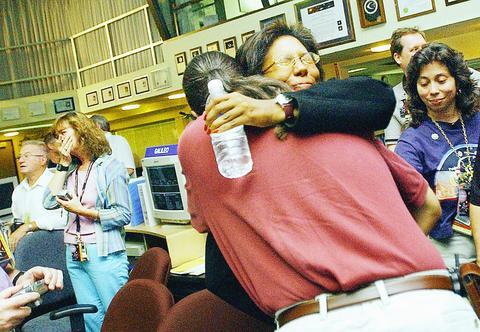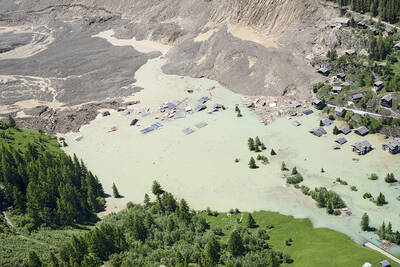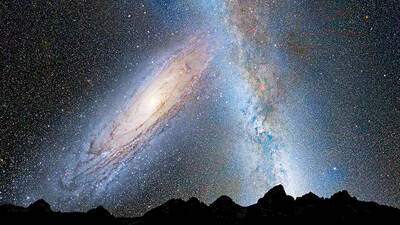NASA's aging Galileo spacecraft plunged into Jupiter's turbulent atmosphere, bringing a deliberately fiery conclusion to a 14-year exploration of the solar system's largest planet and its moons.
The unmanned spacecraft, traveling at nearly 173,770 kph, was torn apart and vaporized by the heat and friction of its fall through the clouds after it dove into the atmosphere at 19:57 GMT Sunday as planned.
At NASA's Jet Propulsion Laboratory, hundreds of scientists, engineers and their families counted down the last seconds before the spacecraft ended its 4.5-billion-kilometer journey from Earth.

PHOTO: AP
"We haven't lost a spacecraft, we gained a new stepping stone in exploration," said Torrence Johnson, the mission's project scientist.
Rosaly Lopes, another scientist on the mission, called Galileo's descent "a spectacular end to a spectacular mission."
"Personally, I am a little sad. I had the time of my life on Galileo and I'm a little sad to say goodbye to an old friend," Lopes added.
Despite the glitches that plagued Galileo since its 1989 launch aboard the space shuttle Atlantis, it was one of the NASA's most fruitful missions, at a cost of US$1.5 billion.
During its thrice-extended mission, Galileo discovered the first moon of an asteroid, witnessed the impact of a comet into Jupiter and provided firm evidence of salty oceans on three of the planet's moons.
Scientists consider one of the three, Europa, the most likely place in the solar system to harbor extraterrestrial life.
Among the most stunning of the 14,000 images returned by Galileo were those of the moon Io. Galileo caught some of the moon's more than 150 volcanoes actively spewing lava and plumes of dust and gas.
"It had more surprises, better stuff waiting to be discovered than we ever could have imagined," said Andy Ingersol, a Jupiter scientist at the California Institute of Technology.
The last of Galileo's science measurements arrived on Earth after the spacecraft was destroyed Sunday, taking 52 minutes to cross space at the speed of light.
"I just can't believe the spacecraft collected data all the way in," said a tearful Claudia Alexander, Galileo's seventh and last project manager.
NASA initially considered leaving Galileo in orbit after it depleted its onboard store of fuel, which was used to trim its course on each of its 35 spins around Jupiter.
Instead, it opted to crash the 1,350kg Galileo to eliminate the possibility it could smack into the watery moon Europa and contaminate it with any microbes aboard. Were Earth bugs to survive on Europa, they could compromise future attempts to probe the moon for indigenous life, scientists feared.
NASA intends to return to Jupiter in a decade with another unmanned spacecraft called the Jupiter Icy Moons Orbiter.
Galileo is the first planetary spacecraft NASA has intentionally destroyed since it steered the Lunar Prospector into the Earth's moon in 1999.
It is not the first, however, to dive into Jupiter: A probe released by the spacecraft did so in 1995, collecting data about the planet's atmosphere for about an hour before it was destroyed.
The largest challenge of the Galileo mission was the loss of the use of the spacecraft's umbrella-like main antenna, which failed to unfurl two years after its 1989 launch. That forced NASA to rely on a smaller antenna, which severely squeezed the amount of data Galileo returned to Earth.
The intense radiation close to Jupiter also took its toll on the electronics of the spacecraft, itself powered by radioactive plutonium.
Still, NASA said Galileo met 70 percent of its science objectives, including an analysis of the composition of Jupiter's atmosphere and a probing of the faint rings that circle the planet. Galileo also investigated the dynamics of the magnetic environment surrounding the solar system's largest planet and made a reconnaissance of its planet-sized moons.
The spacecraft was named for Galileo Galilei, the Italian astronomer who discovered Jupiter's four largest moons in 1610 and whose understanding of the mechanics of the solar system sometimes ran afoul of Vatican orthodoxy.
"Remember, he wanted the truth, whatever it was," said Jim Erickson, a former Galileo project manager. "And we provided it."

The collapse of the Swiss Birch glacier serves as a chilling warning of the escalating dangers faced by communities worldwide living under the shadow of fragile ice, particularly in Asia, experts said. Footage of the collapse on Wednesday showed a huge cloud of ice and rubble hurtling down the mountainside into the hamlet of Blatten. Swiss Development Cooperation disaster risk reduction adviser Ali Neumann said that while the role of climate change in the case of Blatten “still needs to be investigated,” the wider impacts were clear on the cryosphere — the part of the world covered by frozen water. “Climate change and

Poland is set to hold a presidential runoff election today between two candidates offering starkly different visions for the country’s future. The winner would succeed Polish President Andrzej Duda, a conservative who is finishing his second and final term. The outcome would determine whether Poland embraces a nationalist populist trajectory or pivots more fully toward liberal, pro-European policies. An exit poll by Ipsos would be released when polls close today at 9pm local time, with a margin of error of plus or minus 2 percentage points. Final results are expected tomorrow. Whoever wins can be expected to either help or hinder the

DENIAL: Musk said that the ‘New York Times was lying their ass off,’ after it reported he used so much drugs that he developed bladder problems Elon Musk on Saturday denied a report that he used ketamine and other drugs extensively last year on the US presidential campaign trail. The New York Times on Friday reported that the billionaire adviser to US President Donald Trump used so much ketamine, a powerful anesthetic, that he developed bladder problems. The newspaper said the world’s richest person also took ecstasy and mushrooms, and traveled with a pill box last year, adding that it was not known whether Musk also took drugs while heading the so-called US Department of Government Efficiency (DOGE) after Trump took power in January. In a

It turns out that looming collision between our Milky Way and Andromeda galaxies might not happen after all. Astronomers on Monday said that the probability of the two spiral galaxies colliding is less than previously thought, with a 50-50 chance within the next 10 billion years. That is essentially a coin flip, but still better odds than previous estimates and farther out in time. “As it stands, proclamations of the impending demise of our galaxy seem greatly exaggerated,” the Finnish-led team wrote in a study appearing in Nature Astronomy. While good news for the Milky Way galaxy, the latest forecast might be moot